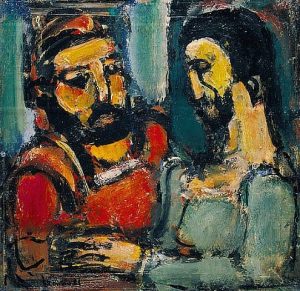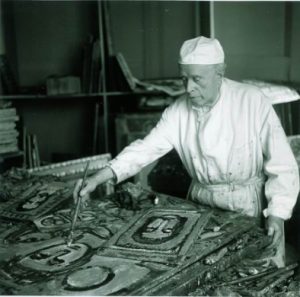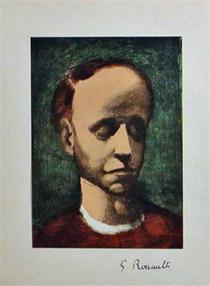He was born on the 27th of May in 1871 in Paris, France.
1871 - 1958
Georges Rouault

description
Georges Henri Rouault was a French artist and graphic artist whose work played an important role in the formation of Fauvism and Expressionism in painting.
He was born into a poor family. His parents gave him as a pupil to glazier Tamoni, and then as an apprentice to a stained glass workshop.
Georges Rouault was one of the most brilliant artists of the early twentieth century, who not only expressed the general tendencies of his time, but also introduced something completely new and fresh in contemporary art. The artist was one of the founders of the Autumn Salon in 1903, and took part in the sensational exposition of the Fauvists, whom critics called “wild” for the excessively intense colors of their paintings, in 1905. Rouault created illustrations and ceramics, as well as was engaged in creating a stage design. He is the author of the scenery and costumes for S. Prokofiev’s ballet “The Prodigal Son” directed by S. Diaghilev. At the end of his life, the artist made a large number of stained glass windows, which are distinguished by their extraordinary color expressiveness.
Key ideas:
– During his long creative life, the artist tried his hand in various styles and genres, leaving an indelible mark of his brilliant talent everywhere. Despite the fact that Georges Rouault closely communicated with the Fauves and participated with them in joint exhibitions, his work in many respects differs from the joyful and carefree style of Matisse, Derain, Vlaminck and their comrades. First of all, in the presence of social satire, ridicule of human vices – features that can be clearly traced in the series “Judges”, “Clowns” and “Convicted”.
– Rouault often chose human flaws as the theme for his works. The artist painted prostitutes and circus artists, especially clowns and gymnasts. The clowns of Rouault are always sad, while the prostitutes are completely devoid of a kind of Romanticism, which was often attributed to them by other artists. The painter portrayed these people in all their unattractiveness, their faces clearly show a trace of dishonor, greed and complacency, as well as fatigue from life and boredom. This approach to painting was a rarity among the French, who primarily cared about the aesthetic side of their art. One art critic said: “Georges Rouault, in his tragic worldview, destroys the framework of traditional French good taste.”
– In addition to social themes, the artist was always interested in the divine subject. We can say that the art of Georges Rouault is the most devout of all avant-garde artists. His numerous images of Christ, Mother of God and saints are very reminiscent of church stained glass, which the artist created when he was young. The faces of saints are sublime and sad, as if immersed in meditations about the fate of human.
– In all the works, whether it be a caustic satire, lofty biblical stories or portraits of contemporaries, the artist uses an energetic manner of painting and rich deep tones. Color spots are delineated by wide black lines, while rare bright areas create a sense of sunlight. Sharp contrasts of bright color spots give dramatic images even more expressiveness and alarming sound.
1871
1885
1891
1901
1903
1910
1912
1917
1921
1958
The birth of the artist
He began his studies
He began his studies at the evening department at the School of Decorative Arts.
Entered the School of Fine Arts in Delaunay's studio
Entered the School of Fine Arts in Delaunay’s studio, and after his death became a student of Gustave Moreau.
He became acquainted with the ideas of Huysmans, who had a great influence on the artist
During the visit to the Benedictine abbey Ligouge, he became acquainted with the ideas of Huysmans, who had a great influence on the artist.
Became one of the founders of the Autumn Salon
Became one of the founders of the Autumn Salon – the annual exhibition of avant-garde artists. Took part in a notorious exhibition of the Fauves in 1905.
The first personal exhibition of the artist was held the gallery Druet
The first personal exhibition of the artist was held the gallery Druet.
The artist's father died
The artist’s father died. It was very difficult for the artist to deal with. In the same year, he began to work on a series of engravings for the book “Miserere”, which lasted about 10 years.
Signed an exclusive contract with A. Vollard
Signed an exclusive contract with A. Vollard, who provided him with a stable income and participation in various exhibitions.
The first monograph on the work of Georges Rouault was published
The first monograph on the work of Georges Rouault was published. In subsequent years, the artist continued to work hard, created beautiful stained-glass windows for the Cathedral of Notre-Dame in Assi, stage scenery for the ballet, objects of decorative and applied art.
The death of the artist
Georges Rouault died on the 13rd of February in 1958 in Paris.










